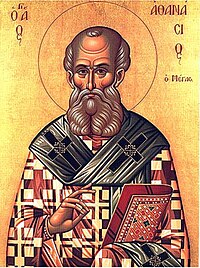Click here to return to 5) Western Renewal, Eastern Decline
Early Christianity
Early Judaic Roots
Christianity began as a unique
rogue sect within Judaism. The first 50 years of Christianity were confined to the apostles and early christians who followed the prescripts of the law of Moses.
Christ and his disciples were Jews and early non-Jewish converts to Christianity had to first become Jews, which included the
circumcision of all Gentile males, including adults.
 |
| Chist and Apostles |
Subsequently, Christ had even warned the apostles
not to go amongst the Gentiles [Matthew: 10: 5-42] and to
confine their conversions to the house of Israel [Matthew: 15:24]. However, after several
confrontations between Saints Paul and Peter, Paul eventually swayed the young church to
convert the Gentiles, which ultimately led to the
abandonment of Jewish rites and the development of
Christianity, an entirely separate religion, complete with
canon law,
polity,
eucharistic liturgy, and
sacramental rites.
By the end of the first century, all church leadership roles were filled by
Gentiles. After the Council of Nicaea, church leadership would become more involved in the
development of canon and liturgy. Missionary work was delegated to the
monastical members, who would emulate the life of Christ, disciples, and the
greatest of missionaries, Saint Paul of Tarsas. Post-Nicaea monks and hermits would include
Saint Paul of Thebes (d. 341 CE), residing in Egypt and
Saint Anthony the Great (251–356 CE) who came to be known as the
"Father of All Monks".
The Hatching of Sects
Inability to Support Multiple Interpretations
Constantine had ordered the assembly of the
Council of Nicaea in 325CE to settle the division, debate and disruptive disagreement amongst 4th century Christians over
the controversy of Christ’s divinity and thereby establish a
foundation for Church canon. The fist step towards
singular monarchianism was the
Nicene Creed. During the council,
Emperor Constantine became directly involved in approvals and subsequent sanctions placed upon
different Christian sects (and there were many) which had developed within the Church.
The most prominent sects at that time were
Arianism and
Gnosticism. However, Arianism struck close to the Emperor's throne.
Eusebius of Nicomedia, an Arian bishop, had a
spiritual relationship with the Emperor’s sister. Constantine’s own son,
Constantius II (to
follow Constantine to the throne) was an Arian Christian.
However, Constantine was by then fully committed and was therefore obligated to make a show of resolve. Consequently, the council condemned and deposed Arius along with other Arian bishops and theologians that were then exiled. The emperor also
had copies of Arius’ teaching, the Thailia, gathered and burned in front of the council.
Nevertheless, the Emperor’s resolve would not be sustained. A
Synod was issued a decade later, and
in 335 CE Arius was restored, though he died on his return trip (Some believe his death was a result of the prayers of
Athanasius the Bishop Alexander who opposed his restoration. Others believe it was poison administered during the journey. Perhaps it was a slight variation of both).
Eventually, most of the bishops would be allowed to return after signing vague reaffirmations of faith. Constantine’s sister was again reunited with her spiritual guide
Eusebius, and no effort was made to stop Constantius II, Constantine’s Arian son, from ascending to the throne. Much to the consternation of the anti-Arian church,
Constantine himself was baptized by Eusebius on his deathbed.
Zealots Go Their Way
The Council of Nicaea may have begun to identify heretical elements between clashing sects, but it did not bring an end to those sects. This would be a process the Church would continue to deal with over the centuries,
even up to the Reformation of the 16th Century.
As the church fathers
continued to formalize canon, it would be left to pious monks to venture beyond the empire's frontiers to spread what
gospels they cherished most. Their missions would carry them far beyond the watchful eye and control of the developing church.
The Syrian Event
Missionaries of the Renounced Sects
After striking out on their own, many renounced sects (i.e.:
Arian and
Gnostic) would ignore the
dictates of Nicaea. Zealous followers would view the judgements of Nicaea as the corrupt work of
bishops seeking power and position within the newly imperialized Church. The post-Nicene usurping and
banishment of bishops and the subsequent installation to those same offices by their accusers must have appeared as confirmation to any such suspicions. There would also be
monks and hermits already committed to missions far from the reaches of the church that would remain oblivious to the council having ever occurred. In any event, for centuries to come, the Arians and Gnostics would continue in monastic roles to profess the faith they cherished and believed in, just as it had been passed on to them.
You may recall the
Ulfilas mentioned earlier in Part IV of this series. Ulfilas, who lived in the 4th Century is today renowned for his conversion of the Goths and translation of the bible from Greek to the Gothic alphabet (not that many Goths could read). An eventual beneficiary of Ulfilas’s Arian teaching would have been the Visigoth leader,
Theoderic the Great, who successfully ruled western Europe after the deposition of the
last Western Emperor.
 |
| Camel Caravan |
The Hermit Monk and The Boy
Sometime
around 580 CE, a caravan passed by the residence of
the monk Bahira. The hermit monk appeared from his cell and asked the members of the Caravan if they would stop and feast with him. They accepted the invitation and chose a boy within the caravan to care for the camels. Bahira insisted that everyone, including the boy, should join him.
As the story goes, during the course of their stay the monk observed a strange aura following the boy. It appeared to accompany him wherever he went throughout the visit. Now convinced the event was part of a recurring dream, the monk approached the boy’s uncle and guardian, an Arab trader by the name of
Abu Talib (Abu Talib ibn ‘Abd al-Muttalib), who was chief of the clan. Bahira explained his revelations involving the boy and the strange aura as a foretelling the boy was to become a great prophet. The monk then instructed Abu Talib to preserve the boy from influence by the
Jews and the
Byzantines (post-Nicene Christians). The boy was
Muhammad.
Commentary
Throughout this cycle of
monotheistic evolution the one outstanding characteristic is the
questioning of Christ's divinity. The Apostles turned to convert Gentiles because belief in Jesus' divinity was too big of a pill to for their fellow Jews to swallow. The same could be said of Christian reaction towards
Muhammad, a prophet appearing after the Christ. Conversely, Christians continued to embrace much of the Abrahamic beliefs inherited from the Jews. The same can be said for
Muslims, in regard to both
Abrahamic belief and the presence of Jesus within the
Quran. Jesus appears 25 times in the Quran, Muhammad just four, and once again as "Ahmad". The Quran tells of Mary's immaculate conception, of Jesus' birth, and his miracles. Yet, it professes an illusion to Christ's death on the cross, because he could not be killed, and that God instead
"...raised him unto himself". This belief that Christ's body was not human is referred to as "
Docetism" and has its roots in
Gnosticism. Docetism was a common thread amongst many early Christian sect. Islam also disagrees with trinitarianism, finding it polytheistic, insisting God worked miracles through a non-divine Jesus.
Like the
Gospels, the
Quran preaches the
distribution of wealth while discouraging the accumulation of wealth and material possessions. This too was the driving force behind the early monks, like those mentioned in this article, who set out to do Christ's work away from the administrative restrictions and scrutiny of the developing Church.
Monasticism may have evolved simply because the Church became too wrapped up in itself. Apparently,
Muhammad and
Islam traveled on a different path towards similar goals. Perhaps Islam is today where
Christianity once was, consumed by it own
liturgy, set upon by fundamentalist divisions, but still active amongst the poor preaching social justice. Ultimately, religions are defined by the people who practice them. Like early monastic Christianity, the social message of Islam today finds its greatest audience amongst the poorer classes, and there is more poverty in the world today than at anytime in its history
.
Click here for 7) Imperial Decline and Seeds of Islam
Got Feedback?
Comments? Questions? Corrections? Any feedback at all? Just click on the comments box at the bottom of this page and enter your thoughts. All comments are welcome.
You might also be interested in...
Copyright ©2013 Tom Mallon. All rights reserved.





.jpg)









